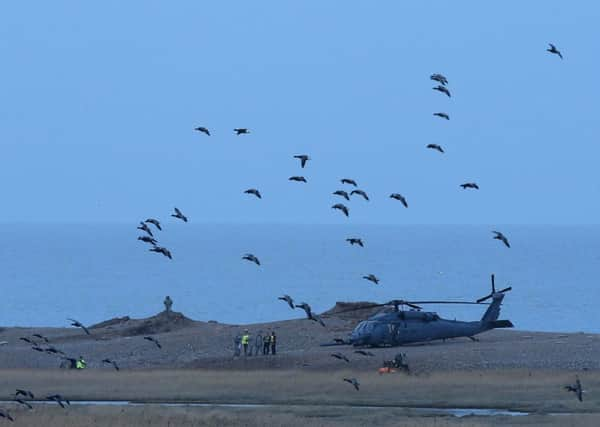Helicopter crash pilot knocked unconscious by geese


The HH-60 Pave Hawk helicopter, operating out of RAF Lakenheath in Suffolk, crashed near Cley-next-the-Sea on 7 January during a training exercise.
Yesterday, the US air force issued the findings of its investigation, saying Brigadier General Jon Norman, president of the inquiry’s board, had “found clear and convincing evidence that multiple bird strikes caused the mishap by rendering the pilot and co-pilot unconscious and disabling the trim and flight path stabilisation system”.
Advertisement
Hide AdAdvertisement
Hide AdCaptains Christopher Stover and Sean Ruane, technical sergeant Dale Mathews and staff sergeant Afton Ponce all died when the helicopter came down on marshland near the village.
They were serving with 56th Rescue Squadron, 48th Fighter Wing, which carries out search and rescue operations.
The report, compiled by the Accident Investigation Board, explained that the purpose of the training mission was to recreate a night-time rescue scenario involving a downed F-16 pilot.
It added that as well as the loss of life, the crash cost the US government an estimated $40.3 millon (£23.5m).
It read: “A flock of geese took flight from Cley Marshes, likely startled by the noise of the approaching helicopters, and struck the MA [mishap aircraft].
“At least three geese penetrated the windscreen, rendering the pilot and co-pilot unconscious, and at least one goose struck the aerial gunner, rendering the gunner unconscious.
“In addition, at least one goose hit the [aircraft] nose, disabling the trim and flight-path stabilisation systems.
“These four airmen were known to those they loved as brother, son, father, husband, sister, daughter, mother, wife, and friend,” wrote General Norman.
Advertisement
Hide AdAdvertisement
Hide AdThe report said the pilot had “followed the available guidance on bird hazards in the UK”.
With the pilot and co-pilot unconscious and stabilisation systems disabled, the helicopter’s control stick would have moved randomly, the report adds.
As a result, the helicopter banked to the left and, unable to lift vertically, hit the ground within about three seconds of being hit by the geese.
Richard Kelham, chairman of Cley Parish Council, said residents had long-held concerns about low-flying helicopters over the marsh, which is a Norfolk Wildlife Trust bird reserve.
He said: “These findings strengthen our hand in the argument against low-flying over nature reserves.
“Our concerns are for both the welfare of the wildlife but also from a safety point of view.
“It is inherently dangerous to fly low over an area with a lot of birds and hopefully lessons can be learned from this tragedy.”
The MoD said it had received 11 complaints about low flying in 2013, none of which were made by people living in the Cley area. These related to the noise created by aircraft and not safety risks.
Advertisement
Hide AdAdvertisement
Hide AdA “seasonal avoidance” notice had been in place between April and September each year since 2012 following an application from the wildlife trust but this accident happened outside that period.
An MoD spokesman said it had no new comment in light of the report, but previously said: “We understand that military low flying can be noisy and unpopular but it is an essential part of operational training.
“In addition the MoD takes the protection of wildlife and habitats very seriously and liaises constantly with the joint nature conservation committee.”
The type of geese involved in the crash typically weigh 6-12 lbs (2.7-5.4kg).